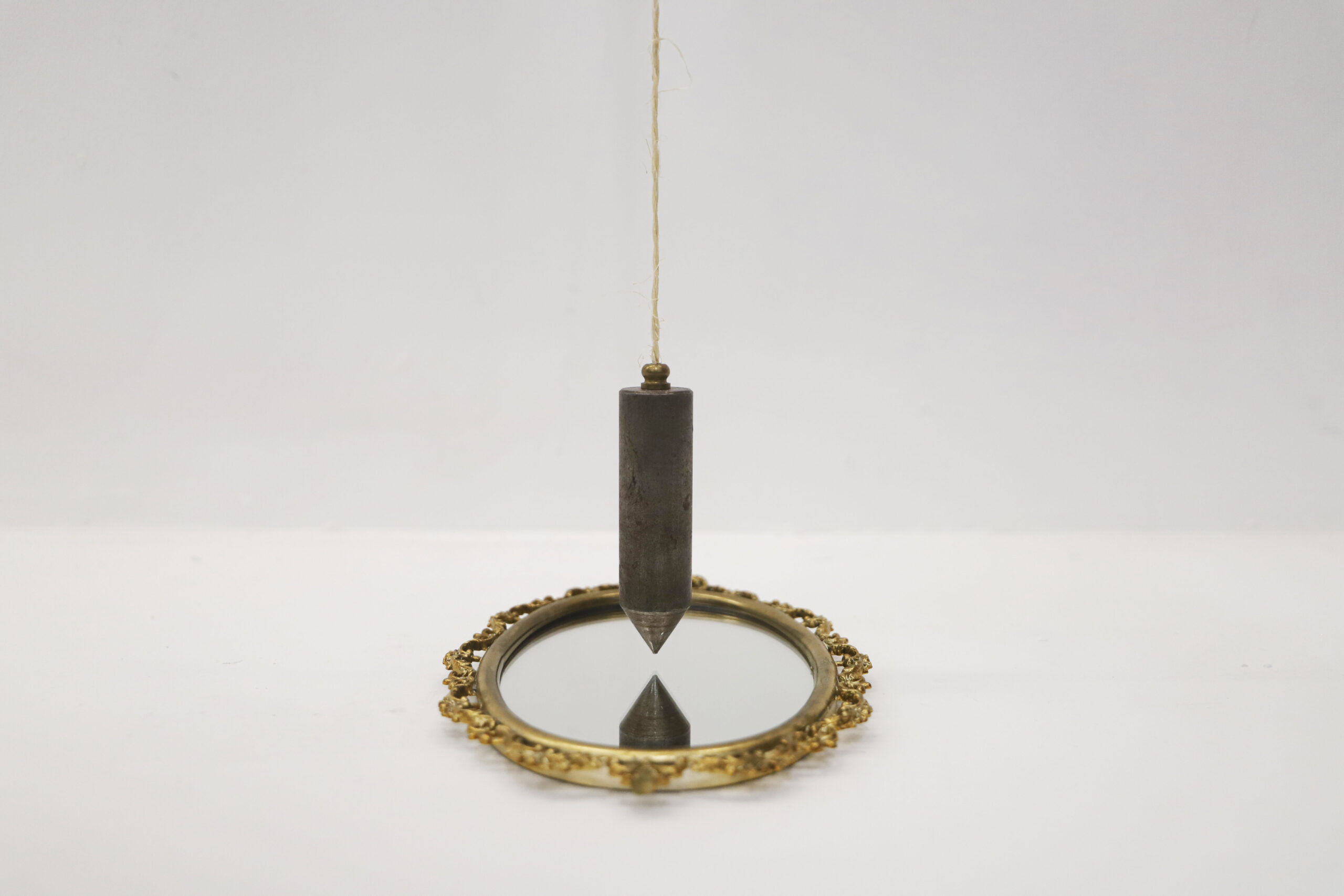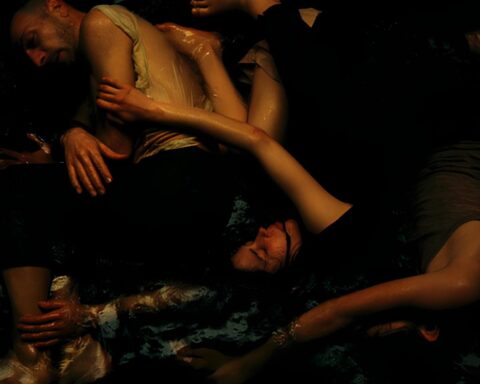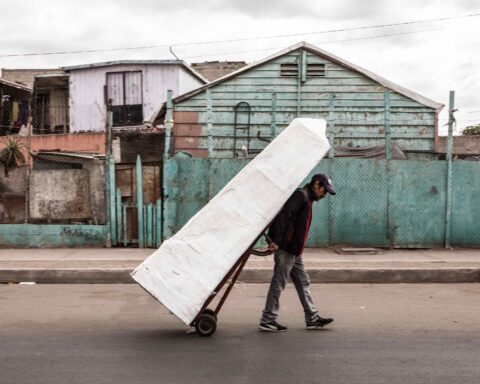Tales from the inside_out: lost in the mirror is the last exhibition of the 2022 season of co_atto, a project space founded by Stefano Bertolini, Ludovico Da Prato, and Marta Orsola Sironi, and hosted in eighteen display windows located inside the Porta Garibaldi railway and underground station in Milan. The exhibition presents the artworks of Stefano Bertolini, Izaak Brandt, Nicole Colombo with Federico Fontanella, Matteo De Nando, Luca Loreti, Domenico Ruccia, Adelisa Selimbašić, Elio Ticca, as well as Martin Hotter, representing the Viennese gallery Vin Vin.
Being the first co_atto exhibition that mainly focuses on pictorial artwork, Tales from the inside out: lost in the mirror questions the current forms, boundaries, and possibilities of pictorial research, investigating the concept of representation and the challenges behind images’ conquest and loss. Each artist wonders about the concept of alterity, through innovative linguistic patterns that move within contemporary narrations and prejudices. As part of the curatorial season Tales from the inside_out, the project establishes a new dialogue with the anonymous and nomadic public of the railway station, overcoming the conventional relationship between artwork and audience typical of institutional exhibitions.
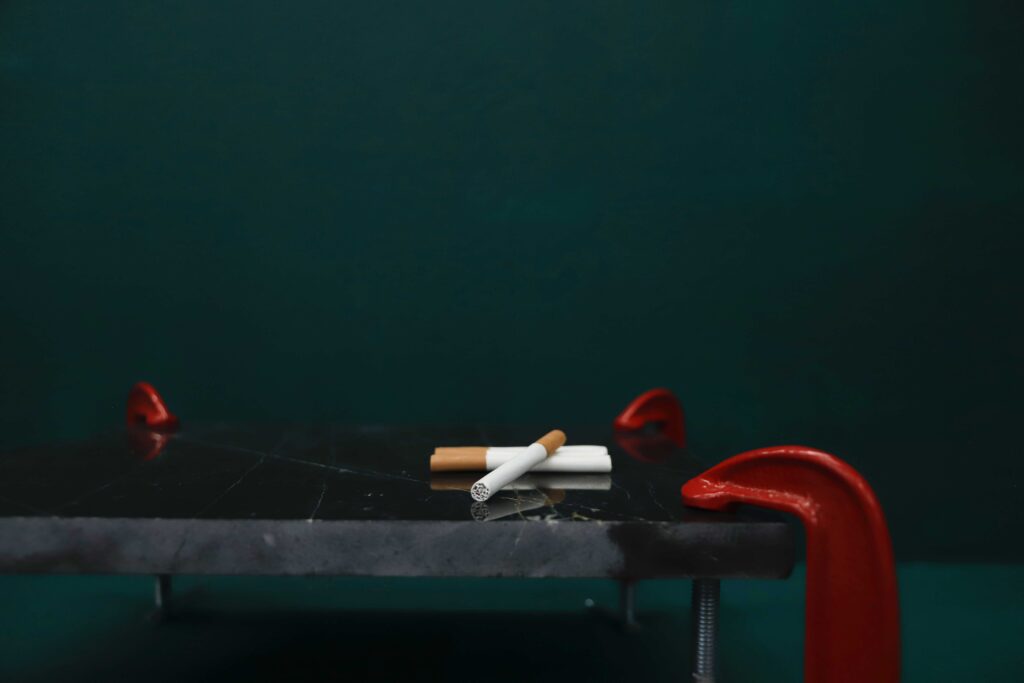
Although the site-specific nature of the artworks is preserved, the exhibition aims to emphasise the idea that each displayed piece is a physical object with a self-contained meaning. On the one hand, the works of Stefano Bertolini, Izaak Brandt, Martin Hotter, Nicole Colombo and Federico Fontanella highlight the materiality of the artworks and their display; on the other hand, the artworks of Adelisa Selimbašić, Matteo De Nando, Luca Loreti, Domenico Ruccia, and Elio Ticca emphasise the figural dimension of the finished product and its creation process. The exhibition path allows the audience to move from pragmatic reflections on the contemporary consumer culture—enabled by the presence of a hybrid relationship between design and art—to more metaphysic and systemic narrations. The artworks displayed propose an irreverent and meditative storytelling, that questions the visual and cultural archives of the audience.
The first artworks that the audience encounters when walking down the mezzanine floor that brings travellers from the underground to the platforms of the surface railway station are those of the London-based multidisciplinary artist Izaak Brandt. Two display windows facing each other host Window Shoppers, a site-specific work related to societal lusting over branded objects and the artists’ continual exploration of what culture and society deem as valuable. Reminding Brandt’s sculptural series Deadstock, this work explores the collecting of rare shoe silhouettes and the archival collecting process that results in the functional object turning sculptural. Then, Brandt exhibits some large-scale faces staring at the shoes trapped in a collective hypnosis and stimulating the audience to reflect on their own addiction to consumer culture. Moreover, Izaak Brandt’s artworks for co_atto focus on the procedural and technical processes of drawing and painting, as demonstrated by the use of 3D pencil for the realisation of the shoe silhouettes.
The second pair of display windows hosts the artistic duo composed of Nicole Colombo and Federico Fontanella, presenting Quotidiano surreale, a dialogue between objects that combine art and design, defining a space that is at the same time attractive and repelling. As particularly evident in the ink-on-paper works realised by Nicole Colombo, the artists attempt to establish a still frame of a specific situation, a narrative not necessarily experienced by the protagonists, but hypothetical and potential. The display windows create a variety of atmospheres and physical spaces, that dialogue with the artworks and stimulate the imagination of the audience to create their own personal narrations.


Continuing to walk down the mezzanine floor, the audience encounters Stefano Bertolini’s work. From design to art, from mathematics to geometry, the artist works in an interstitial dimension, tracing continuous connections and references between different disciplines and techniques. Numbers become a material instrument, a tool used to give light to an image shaped by the context around it. The artwork originates from the combination of the author’s will and creativity and the use of pre-defined schemes of representation. This dialogue generates endless and undefined possibilities, a space without limits, where numbers guarantee the rationality of thoughts. Stefano Bertolini’s artworks also propose a metalinguistic research on the concepts of frame and mirror, as in Reiterazione.
Next, the work of the German artist Martin Hotter, who reflects on how sense and purpose are degradable concepts. Untitled – für Ottmar consists of four copper sculptures representing empty and slightly squeezed upright-standing vinyl record covers, whose natural patination process was partly accelerated with acid. Hotter dedicates this series of replicas to his former professor, Ottmar Hörl, defined as “a Master of multiples”. In the opposite display window, Hotter presents a site-specific project, this time using repurposed wood coming from the ruins of alpine cabins.
Following the curatorial path, that emphasises the transition from materiality to a more figural dimension, Matteo De Nando’s research constructs an aesthetic image of our consumer society, intending to act as a pharmakon, a word whose meaning is one of both cure and poison. In his work Pluriball, De Nando focuses on the preliminaries and the procedural aspects of any artistic practice, and the importance of the pictorial act as a gestural and manual exercise. In doing so, the artist looks at the hyper-productivity of the present days, rejecting its automatism and bringing the artistic practice back to a physical, intimate and artisanal dimension. In realising his works, as in Shopper (Italian Blue Sky), De Nando creates formal associations with very recognisable objects from everyday life, sometimes sublimating pop culture’s elements and sometimes vulgarising the lyrical concept of art.
One pair of display windows after the other the audience is now deeply immersed into the exhibition. The art-curious people that came to the station to visit the exhibition share the floor with casual visitors that bumped into the show in the middle of their daily commuting. At this point, both types of audience forgot that they were walking inside a railway station.
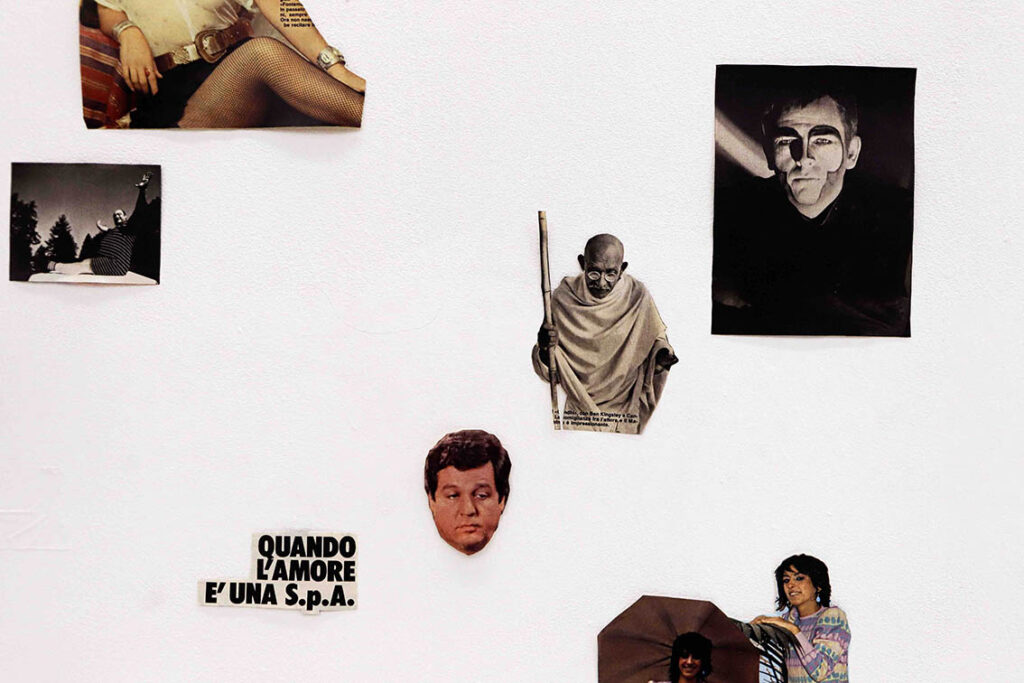
Domenico Ruccia’s artworks propose a parodical and erotic reinterpretation of the entertainment scene of the ’70s and ’80s. The homage to the Italian film culture is evident: from Federico Fellini’s magical oneirism to the second-rate products of the Italian sex comedy. The aesthetic means of those decades are used as a valuable tool to link the past with the present and investigate what aspects of the Italian heritage are still visible in contemporary art. But Ruccia’s work goes beyond a patriotic tribute, exploring how the Italian culture compares with foreign ones, particularly American and Oriental. Commercials, movie images, and clippings from popular entertainment magazines and commercial products are turned into paintings that recall the collage technique. The opposite display window contains Leggigli la mano, an artwork representing the visual models of the paintings mentioned above, in the form of a procedural and archive work.
In the following pair of display windows, the Italo-Bosnian artist Adelisa Selimbašić focuses on forms through the representation of women’s bodies, to which Selimbašić gives voice by destructuring the contemporary and objectifying idea of physical perfection. Selimbašić’s painting represents women’s physical presence in a mischievous way, alluding to sexuality and showing erogenous zones, but staying away from a pornographic representation. For the occasion, Adelisa Selimbašić presents a large painting that dismantles the aseptic nature of the display window and its function of containing items for sale. In the opposite display window, a number of serigraphies explore the aesthetic imaginary of women, through fragmented images of their bodies, representing only hands and coloured nails.
Through camouflage and recreation processes, Elio Ticca’s research investigates the links between historical and contemporary artistic languages, authenticity and fictionality. Ticca merges surrealism, pop aesthetics, and magical realism, with references to the music and storytelling practices. As it emerges from I’ll Be Your Perfect Match – Apollo for Breakfast, Ticca’s artworks for co_atto aim to explore how the representation of pathos can be deconstructed and re-narrated into new forms. Elio Ticca’s display windows recreate the appearance of a room that, combined with the trompe l’oeil technique, provides a mean for the audience to escape the chaotic scene of the railway station.
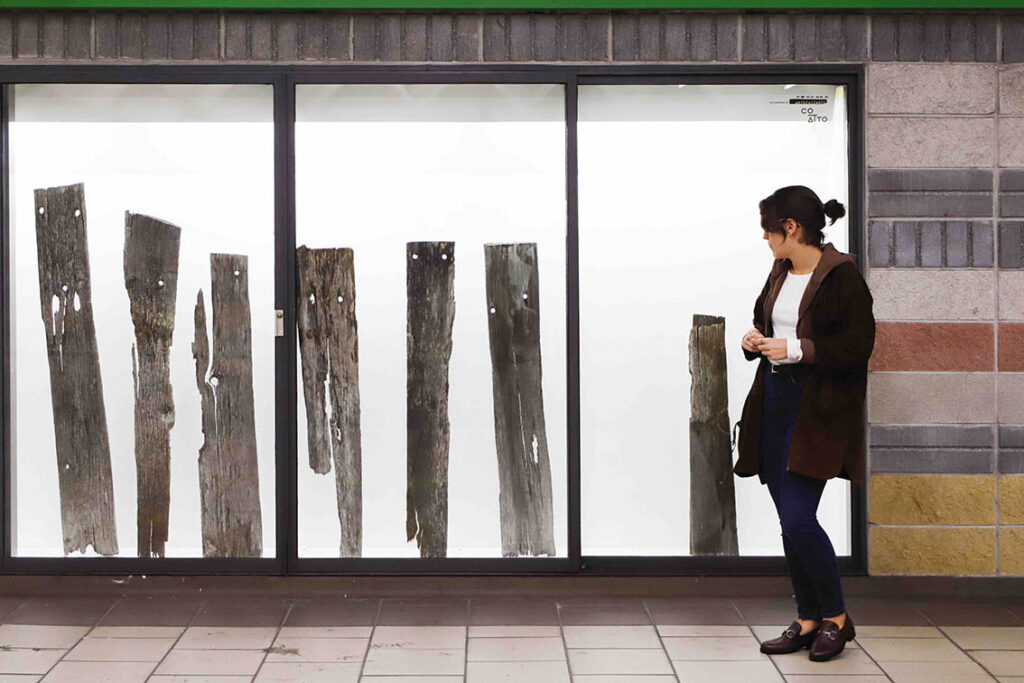
The exhibition path finishes with the work of Luca Loreti, which starts from the assumption that visual arts are a human practice and a way to investigate the world around us and the intrinsic nature of human beings. The artwork Argo and Kira, in particular, emphasises the semantic and stylistic convergence that unites traditions very far in time and space. Inside Luca Loreti’s display windows, a pair of rusty steel painted lions sculptures stands on a marble base, reminding Foo Dogs (Imperial Guardian Lions), the traditional statues typical of Chinese royal palaces, but also the decorative and apotropaic elements placed at the entrance of Western villas, churches, and royal palaces.
We are now at the end of the exhibition path. Art-conscious people have experienced how pictorial and figurative art is capable of going beyond the static and traditional dimensions, moving into the categories of original and performative. Travellers who bumped into the exhibition in the middle of their commuting, without choosing to visit it in the first place, have unexpectedly found themselves carried into a new dimension. This is the power of this exhibition: art is horizontal and democratic, and visitors of all types, each one in their own way, can find themselves lost in the mirrors of the display windows.
